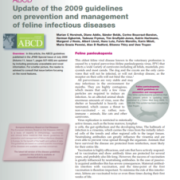GUIDELINE for Mycobacterioses in cats
Mycobacteria are intracellular, acid-fast, slow-growing bacilliform Gram-positive aerobic bacteria, highly resistant to environmental conditions (Greene and Gunn-Moore, 2006; Gunn-Moore, 2010). Mycobacterial taxonomy is complex, and many species can infect cats and cause different clinical presentations.


















